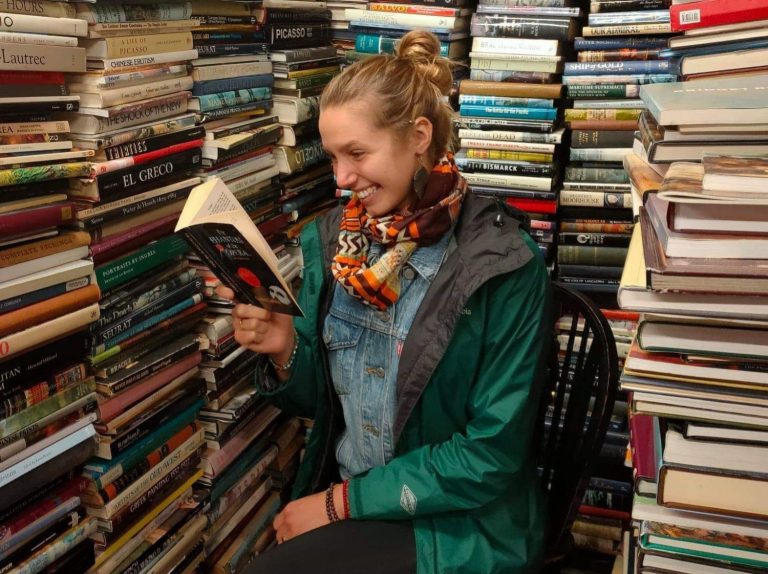For our staff profile series we spoke to Danielle Kurtin, former MSc Translational Neuroscience student and now Postdoctoral Research Associate about her Imperial College Fellowship and inspiration for pursing a career in neuroscience.
Introduce yourself – who are you and what do you do?
Hiya, I’m Danielle! I’m a postdoc split between three groups, which underscores the interdisciplinary nature of my research. My work focuses on how multimodal neuroimaging and neuromodulatory interventions (such as Temporal Interference (TI) stimulation and psychedelic drugs) can develop both a mechanistic understanding and therapeutic interventions for substance (mis)use/dependence.
Tell us about your career so far – when did you join the college, and where were you working/studying before this?
Growing up in a small fishing town in Florida cultured my love for biology, which I explored at Florida State University through a BSc in Biological Sciences. In the last semester of my undergraduate degree I took a human physiology course that had a scant two weeks of neuroscience. It wasn’t much, but it was enough to pique my interest, which I followed through interning at the Netherlands Institute for Neuroscience while waitressing on canal boats at night. This experience solidified my passion for neuroscience, which I pursued through the MSc Translational Neuroscience at Imperial, from 2018-2019. The MSc not only gave me a theoretical foundation of neuroscience, but also unlocked a whole world of coding, brain stimulation, and neuroimaging analysis. I utilised and developed my newfound computational neuroimaging skills throughout my PhD at the University of Surrey, before rejoining Imperial as a postdoc.
You have just started an Imperial College Research Fellowship. What motivated you to apply, and how did you find the application process?
Compared to a hired post-doc position, a fellowship enables an early career researcher to pursue their own line of investigation and develop research independence. Given how my project unites neuroimaging, substance (mis)use/dependence, TI stimulation, and psychedelic neuromodulation, the Imperial College Research Fellowship was my primary choice. No other institution could better support my diverse research interests. My application process was also unique in that I applied in tandem with Kate Godfrey. Kate is a fellow post-doctoral researcher in the Division of Brain Sciences is also exploring the potential synergistic mechanisms of combining psychedelic-enhanced neuroplasticity with TI’s noninvasive, focal, deep brain electrical stimulation. Rather than consider each other as a competitor, we strategized how our areas of expertise could complement one another’s application. Against the odds, both of us received the same fellowship! This highlights something I have always appreciated about Imperial – the willingness to support collaborations and build a stronger, more diverse research platform.
What initially sparked your interest in your current field?
While my initial exposure to neuroscience was described above, my MSc at Imperial was where I learned neuroimaging and coding. Both of these tools have been at the core of my research practice since I learned them. Neuroimaging enables us to visualise brain structure and function noninvasively, and while all neuroimaging modalities have limitations, I’m learning to conduct multi-modal imaging to build a more comprehensive understanding of brain function. Coding is something I never contemplated doing until Imperial – however, it’s one of the most useful skills I have learned. I liken it to being able to walk into a wet lab and being able to use any tool you want, often for free. The breadth and depth of analysis methods offered computationally are seemingly endless, and I am continually fascinated by how computational neuroimaging sheds new insights into brain function.
What is your favourite part about working in the Department?
Definitely the people. As part of three different labs, I get to work with people from all over Imperial, and each lab has its own culture. Yet, uniting each lab is a shared passion for translational research. This human-centric approach is deeply appealing to me, as my research is driven by a desire to help others, especially underserved communities. Moreover, the consistency in which cutting-edge technology is used to conduct robust, high-quality research means I am continually improving my research, thanks to the collaborative efforts of my colleagues.
When you are not working, what are your main passions and hobbies?
My extracurricular interests are as broad as my academic ones! My primary passion project at the moment is Craving Clarity, a podcast I co-founded to highlight the global dimensions of addiction research. I’m also on the board of trustees for UniArk, an educational charity that supports disadvantaged students in their applications to top-tier US and UK universities. But my more casual hobbies include cooking, writing, running, hiking, dancing, skateboarding, climbing trees. . . anything I can do outside, or with my friends, family, and loved ones makes me happy.
And finally – if you were stranded on a desert island but allowed one luxury item, what would it be?
Ohhhhh that’s a tough question, mostly because I love minimalist camping! But a luxury item I’d choose would be my portable watercolour set, so I could capture the beauty of island’s flora, fauna, and fungi.
